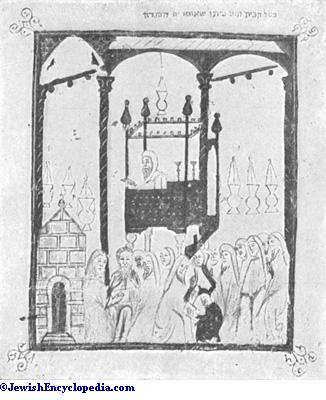PULPIT:
In the earliest time a post ("'ammud" was used instead of a pulpit; from it the king spoke to the people, and from it Josiah renewed with the people the covenant of the Law before the Lord (II Kings xi. 14, xxiii. 3). When Ezra returned from Babylon he "stood upon a pulpit ["migdal"] of wood . . . made for the purpose" (Neh. viii. 4), to read the law of Moses in the street before the people. In the Talmudic and geonic periods the pulpit was placed either on the Almemar or in front of the Ark; in Palestine it was placed on the almemar; elsewhere it was stationed in front of the Ark (See Palestine, Laws and Customs). The Talmudic term for the pulpit is "tebah" (desk). Whenever a fast-day was decreed by the bet din, the desk was taken into the street, and the elder (ḥakam) stood in front of it, facing the people, and addressed them in words of humility (Ta'an. ii. 1). In the synagogue the elders sat in the front row facing the people and with their backs toward the side of the Ark. The desk was placed opposite the people with its back toward the Ark.

Maimonides states that in the center of the synagogue is placed the almemar, on which the reader of the Pentateuch or the preacher stands in order that he may be the better heard. The Zohar likewise placesthe pulpit on the almemar in the center of the synagogue, facing the Ark. The Zohar calls the pulpit "migdal 'oz " (a strong tower; Prov. xviii. 10). The desk is ascended by six steps, above which is an additional step to receive the Pentateuch and to serve as a pulpit for the lecturer. The six steps represent those of Solomon's throne (II Chron. ix. 18; Zohar, Wayaḳhel, Ex. 206a; Isaac Horowitz, "Shelah," Num. 164b).
Pulpit and Almemar.In the case of a large congregation the almemar, with the pulpit, was originally placed in the center of the synagogue in order that the voice of the reader or preacher might be heard by all the worshipers; whereas the ḥazzan stood by the Ark, it being easier to follow him in the familiar prayers. The placing of the almemar with the pulpit in the center of the synagogue was purely a matter of convenience, and not of obligation. In later times, when the congregations became smaller, the almemar was erected nearer the Ark (Caro, "Kesef Mishneh" to "Yad," Tefillah, xi. 3, 4). The case of Orthodoxy against Reform, in the nineteenth century, in regard to taking the almemar from the middle of the synagogue and placing it near the Ark, was not based on Jewish law, but on the adopted custom, strengthened by the desire to avoid the appearance of aping Christian practises.

In modern times the Orthodox Jews still keep the almemar separated from the Ark and about one-third of the length of the synagogue from it. The reader of the Pentateuch, from the desk on the al-memar, faces the Ark. But the preacher's pulpit is on the platform of the Ark and facing the audience.
Individual worshipers also use a pulpit or desk, called a "ständer" or "stodt" (= "statt," "stätte," i.e., place) in which to lock their ṭallit, tefillin, and prayer-books.
- David Schlesinger, Har Tabor, Presburg, 1861;
- Akiba Joseph, Leb ha-'Ibri, p. 76, Lemberg, 1873;
- Schreiber, Reformed Judaism, p. 152.

